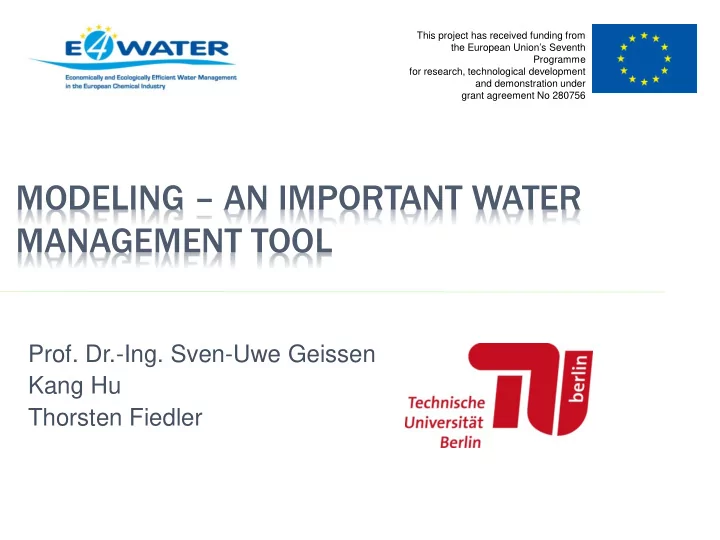

This project has received funding from the European Union’s Seventh Programme for research, technological development and demonstration under grant agreement No 280756 MODELING – AN IMPORTANT WATER MANAGEMENT TOOL Prof. Dr.-Ing. Sven-Uwe Geissen Kang Hu Thorsten Fiedler
CONTENT 1. Introduction 2. Results 3. Summary 2 E4Water Final Conference, Brussels, April 20, 2016
1. Introduction 3 E4Water Final Conference, Brussels, April 20, 2016
Water Research at TU Berlin Centre for Water in Urban Areas since 2000 (FSP-WIB) Cooperation contracts many external partner: Berlin Centre of Competence for Water, BWB, Bayer etc. 22 chairs merging their water knowledge over 5 faculties Four core fields of activity Innovation Analytics Economy International 4 E4Water Final Conference, Brussels, April 20, 2016
MAIN OBJECTIVES Development a model-based integrated management tool to: predict the economical and calculate the ecological effects (e.g. impact on water bodies) of water recycling and the related technologies optimize water treatment technologies, processes and sites demonstrate the potential for freshwater savings, the recovery of heat and valuables 5 E4Water Final Conference, Brussels, April 20, 2016
PARTNERS INVOLVED INOVY N VITO UCM TUB IVL DOW DECH Solvay EMA 6 E4Water Final Conference, Brussels, April 20, 2016
METHODOLOGY integrated urban water cycle (Solid) Waste mangement Natural Water Ressources agriculture integrated urban industry water cycle urban area wwtp process level process level process unit level process unit level TSS = 1,5 g/L fundamentals no aeration Input Output impulse dosage fundamentals • Fundamentals of System and Process Engineering • Environmental Process Enginnering • Wastewater Process Engineering 7 E4Water Final Conference, Brussels, April 20, 2016
MODELS DEVELOPED • Polymerization reactor performance model • Wet cooling tower performance model PVC production process • General mass and energy balance model • Heat exchanger model • MBR ASM, ion removal, energy consumption (aeration and Wastewater pumping) models treatment process • RO ion removal, energy consumption models • Ultrafitration/Nanofiltration models • Electrodialysis model (Master thesis with TNO ) Other models • Membrane distillation model • Activated carbon adsorption model 8 E4Water Final Conference, Brussels, April 20, 2016
2. Results 9 E4Water Final Conference, Brussels, April 20, 2016
INOVYN CASE 10 E4Water Final Conference, Brussels, April 20, 2016
IWEMM FOR INOVYN 11 E4Water Final Conference, Brussels, April 20, 2016
MODEL BLOCK DETAILS 12 E4Water Final Conference, Brussels, April 20, 2016
MBR RESULTS Steady state calibration: Parameter Unit Measured Default ASM1 Default Calibrated ASM 1 value values mbr_ASM1HSG values values g m -3 NH4+-N 1.1 0.14 0.25 0.64 g m -3 NO3-N 12.1 6.2 6.5 12.0 g m -3 MLSS 11254 12970 11720 11580 Avg. Values over 100 days (pilot and model) 13 E4Water Final Conference, Brussels, April 20, 2016
MBR RESULTS Dynamic state calibration: 14 E4Water Final Conference, Brussels, April 20, 2016
SCENARIOS FOR LCA Parameter Different recovery scenarios 25% 50% 75% Recycled water flow 600 1200 1800 (m3/d) MBR parameters Energy consumption 0.74 0.74 0.74 (kWh/m3 water) K2HPO4 7.44 7.44 7.44 Antifoam 17.93 17.93 17.93 Chemicals NaOH 609.6 609.6 609.6 consumptions C6H8O7 12.24 12.24 12.24 (kg/d) NaClO 23.52 23.52 23.52 HCl 2.16 2.16 2.16 Kg excess sludge /m³ process water produced 2.6 2.6 2.6 RO parameters Energy consumption 0.81 0.96 1.27 (kWh/m3 water) Antiscalant 4.2 8.4 12.6 Biocide 0.6 1.2 1.8 Chemicals consumptions Acid cleaning 0.3 0.6 0.9 (kg/d) Alkaline cleaning 0.48 0.96 1.44 Surfactant 0.3 0.6 0.9 Maere, T., et al. (2011). "BSM-MBR: A benchmark simulation model to compare control and operational strategies for membrane bioreactors." Water Research 45 (6): 2181-2190. Veera Gnaneswar Gude(2011).” Energy consumption and recovery in reverse osmosis”. Desalination and Water Treatment. 36 (2011) 239–260. 15 E4Water Final Conference, Brussels, April 20, 2016
GROUNDWATER AND COSTS SAVED 2500 4000 Recycled wastewater snd fresh groundwater(m 3 /d) Recycled wastewater Fresh groundwater required Costs of goundwater 3500 3.418 2000 Costs of groundwater(Euros/d) 3000 2.809 2500 1500 2.389 2000 1.969 1000 1.549 1500 1.129 1000 500 709 500 289 0 0 0 0 10% 20% 30% 40% 50% 60% 70% 80% Wastewater recycling ratio 16 E4Water Final Conference, Brussels, April 20, 2016
HEAT ENERGY 70 70 Heat required in reactor Recycled wastewater temperature 60 60 Recycled wastewater temperature( ° C) Heat required in reactor(kWh/m 3 ) 50 50 40 40 65,3 30 30 55,9 49,9 45,1 41,2 20 20 37,8 34,7 31,9 29,3 10 10 0 0 0 10% 20% 30% 40% 50% 60% 70% 80% Wastewater recycling ratio 17 E4Water Final Conference, Brussels, April 20, 2016
RECYCLED WASTEWATER QUALITY 0,7 7 COD, Cl concentrations (mg/L) and conductivity ( μ S/cm) NH4+ K Mg As Ca COD Cl conductivity NH4+, K, Mg, As, Ca concentrations (mg/L) 0,6 6 0,5 5 0,4 4 0,3 3 0,2 2 0,1 1 0 0 10% 20% 30% 40% 50% 60% 70% 80% Wastewater recycling ratio 18 E4Water Final Conference, Brussels, April 20, 2016
DISCHARGED WASTEWATER QUALITY 200 8000 180 COD NH4+ K Mg As Ca Cl conductivity COD,NH4+, K, Mg, As, Ca concentrations (mg/L) 160 Cl concentration (mg/L) and conductivity( μ S/cm) 6000 140 120 100 4000 80 60 2000 40 20 0 0 10% 20% 30% 40% 50% 60% 70% 80% wastewater recycling ratio The quality meets the discharge limits 19 E4Water Final Conference, Brussels, April 20, 2016
3. Summary 20 E4Water Final Conference, Brussels, April 20, 2016
MAIN OUTCOMES Integrated model to predict: Water consumption Water quality Energy usage Scenarios Environmental impact (together with LCA) Transfer to other sites can be used to visualize flows for planned and existing sites Training of employees Process models: Combining them to simulate treatment trains Predict effluent qualities Scenario analysis 21 E4Water Final Conference, Brussels, April 20, 2016
MAIN OUTCOMES 22 E4Water Final Conference, Brussels, April 20, 2016
Thank you for your attention! 23 E4Water Final Conference, Brussels, April 20, 2016
Recommend
More recommend